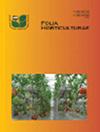Analysis of the contents of Ugni molinae Turcz fruits across the ripening stages
IF 1.8
4区 农林科学
Q2 HORTICULTURE
引用次数: 0
Abstract
Recently, a growing interest in fruits having a high content of health-promoting compounds has become a trend among consumers around the world. Wild berries have received special attention based on the high levels of healthy compounds present in them. In this work, we elaborate on the qualities of the murta (不同成熟阶段 Ugni molinae Turcz 果实的含量分析
最近,世界各地的消费者对含有大量促进健康的化合物的水果越来越感兴趣。野生浆果因含有大量有益健康的化合物而受到特别关注。在这项工作中,我们详细阐述了不同成熟阶段的马铃薯(Ugni molinae Turcz)果实的品质,如颜色、挥发性有机化合物(VOC)、抗氧化能力和酚类化合物含量(包括黄酮醇和花青素)。根据表皮颜色参数确定了四个阶段,这些参数与榈果重量和大小的变化一致。此外,总酚和黄酮醇含量在果实成熟过程中有所下降,而总花青素含量在成熟的最后阶段有所上升。此外,还通过铁还原抗氧化能力和 1,1-二苯基-2-苦基肼变色测定两种方法对抗氧化能力进行了评估。此外,挥发性有机化合物分析表明,萜类化合物是主要化合物,在完全成熟的果实中相对含量最高。通过这些结果,我们可以提出一种对不同成熟阶段的 murta 果实进行分类的方法。这将使我们能够更好地了解这种有趣的水果,它拥有非常健康的营养保健化合物。
本文章由计算机程序翻译,如有差异,请以英文原文为准。
求助全文
约1分钟内获得全文
求助全文
来源期刊

Folia Horticulturae
Agricultural and Biological Sciences-Horticulture
CiteScore
3.40
自引率
0.00%
发文量
13
审稿时长
16 weeks
期刊介绍:
Folia Horticulturae is an international, scientific journal published in English. It covers a broad research spectrum of aspects related to horticultural science that are of interest to a wide scientific community and have an impact on progress in both basic and applied research carried out with the use of horticultural crops and their products. The journal’s aim is to disseminate recent findings and serve as a forum for presenting views as well as for discussing important problems and prospects of modern horticulture, particularly in relation to sustainable production of high yield and quality of horticultural products, including their impact on human health.
 求助内容:
求助内容: 应助结果提醒方式:
应助结果提醒方式:


